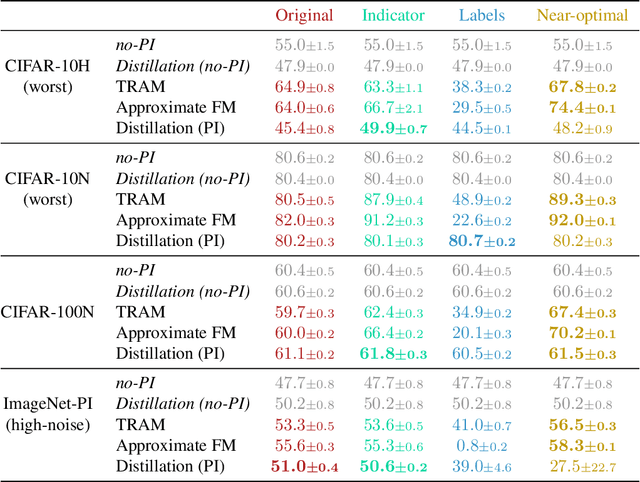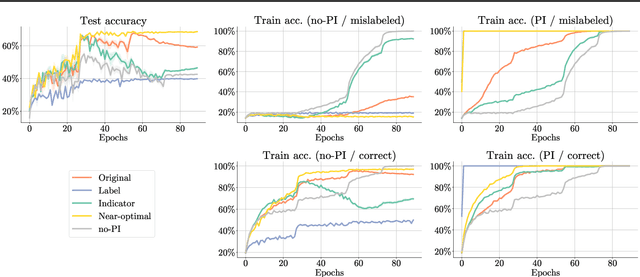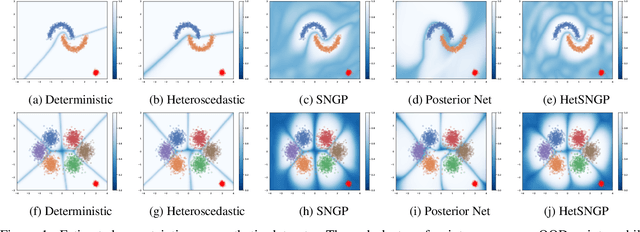Effrosyni Kokiopoulou
When does Privileged Information Explain Away Label Noise?
Mar 03, 2023



Abstract:Leveraging privileged information (PI), or features available during training but not at test time, has recently been shown to be an effective method for addressing label noise. However, the reasons for its effectiveness are not well understood. In this study, we investigate the role played by different properties of the PI in explaining away label noise. Through experiments on multiple datasets with real PI (CIFAR-N/H) and a new large-scale benchmark ImageNet-PI, we find that PI is most helpful when it allows networks to easily distinguish clean from noisy data, while enabling a learning shortcut to memorize the noisy examples. Interestingly, when PI becomes too predictive of the target label, PI methods often perform worse than their no-PI baselines. Based on these findings, we propose several enhancements to the state-of-the-art PI methods and demonstrate the potential of PI as a means of tackling label noise. Finally, we show how we can easily combine the resulting PI approaches with existing no-PI techniques designed to deal with label noise.
Massively Scaling Heteroscedastic Classifiers
Jan 30, 2023



Abstract:Heteroscedastic classifiers, which learn a multivariate Gaussian distribution over prediction logits, have been shown to perform well on image classification problems with hundreds to thousands of classes. However, compared to standard classifiers, they introduce extra parameters that scale linearly with the number of classes. This makes them infeasible to apply to larger-scale problems. In addition heteroscedastic classifiers introduce a critical temperature hyperparameter which must be tuned. We propose HET-XL, a heteroscedastic classifier whose parameter count when compared to a standard classifier scales independently of the number of classes. In our large-scale settings, we show that we can remove the need to tune the temperature hyperparameter, by directly learning it on the training data. On large image classification datasets with up to 4B images and 30k classes our method requires 14X fewer additional parameters, does not require tuning the temperature on a held-out set and performs consistently better than the baseline heteroscedastic classifier. HET-XL improves ImageNet 0-shot classification in a multimodal contrastive learning setup which can be viewed as a 3.5 billion class classification problem.
Deep Classifiers with Label Noise Modeling and Distance Awareness
Oct 06, 2021



Abstract:Uncertainty estimation in deep learning has recently emerged as a crucial area of interest to advance reliability and robustness in safety-critical applications. While there have been many proposed methods that either focus on distance-aware model uncertainties for out-of-distribution detection or on input-dependent label uncertainties for in-distribution calibration, both of these types of uncertainty are often necessary. In this work, we propose the HetSNGP method for jointly modeling the model and data uncertainty. We show that our proposed model affords a favorable combination between these two complementary types of uncertainty and thus outperforms the baseline methods on some challenging out-of-distribution datasets, including CIFAR-100C, Imagenet-C, and Imagenet-A. Moreover, we propose HetSNGP Ensemble, an ensembled version of our method which adds an additional type of uncertainty and also outperforms other ensemble baselines.
Graph-based classification of multiple observation sets
Jul 27, 2009



Abstract:We consider the problem of classification of an object given multiple observations that possibly include different transformations. The possible transformations of the object generally span a low-dimensional manifold in the original signal space. We propose to take advantage of this manifold structure for the effective classification of the object represented by the observation set. In particular, we design a low complexity solution that is able to exploit the properties of the data manifolds with a graph-based algorithm. Hence, we formulate the computation of the unknown label matrix as a smoothing process on the manifold under the constraint that all observations represent an object of one single class. It results into a discrete optimization problem, which can be solved by an efficient and low complexity algorithm. We demonstrate the performance of the proposed graph-based algorithm in the classification of sets of multiple images. Moreover, we show its high potential in video-based face recognition, where it outperforms state-of-the-art solutions that fall short of exploiting the manifold structure of the face image data sets.
 Add to Chrome
Add to Chrome Add to Firefox
Add to Firefox Add to Edge
Add to Edge